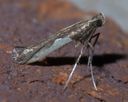Leaf Blotch Miner Moths
Gracillariidae
Classification
- Phylum: Arthropoda
- Subphylum: Hexapoda
- Class: Insecta
- Order: Lepidoptera
- Superfamily: Gracillarioidea
- Family: Gracillariidae
Pronunciation
How to pronounce Gracillariidae: /ɡrəsɪˌlæriˈaɪ.iˌdi/
These audio files are automatically generated. While they are not always 100% accurate, they are a good starting point.
Images






Summary
Gracillariidae, known as leaf blotch miner moths, is a prominent family in the order Lepidoptera, encompassing many species of economic importance, particularly as pests of various plants. Their unique life cycle and ecological role as leaf miners contribute to their significance in both natural ecosystems and agriculture.
Physical Characteristics
Small to minute moths associated with host plants. Top of head rough- to smooth-scaled. Antennae long. FW usually without an accessory cell; HW has a hump along the costal margin near the base in some species. Wingspan 4-20 mm.
Identification Tips
Moths can be identified based on resting posture: Gracillariinae rest with the front of the body steeply raised; Lithocolletinae and Phyllocnistinae rest parallel to the surface, often with the head lowered. Close examination reveals that the antennal flagellomeres have two rows of scales. Male genitalia have only four pairs of muscles and lack a gnathos, while the female ovipositor is short and laterally flattened.
Habitat
Gracillariidae occur in all terrestrial regions of the world except Antarctica. Their larvae can be found in association with a variety of dicotyledonous plants, typically in leaves or other plant parts.
Distribution
Gracillariidae are found in all terrestrial regions of the world except Antarctica, including a notable distribution in North America and various tropical regions.
Diet
The larvae are leaf miners, feeding on sap in early instars and plant tissue in later instars. They typically produce a 'blotch mine' in leaves.
Life Cycle
Most species undergo hypermetamorphosis, with early instars feeding on sap and later being cylindrical with legs and functional mouthparts. Some species have a non-feeding spinning instar; others may mine leaves, roll leaves, or form galls.
Reproduction
Gracillariidae moths exhibit a range of reproductive behaviors associated with their larval feeding habits. Female ovipositors are adapted for laying eggs on suitable host plants for their larvae.
Predators
Specific predators of Gracillariidae are not detailed, but like many insects, they are likely to fall prey to various birds, insects, and other natural enemies.
Ecosystem Role
Gracillariidae play a significant ecological role as leaf miners, impacting the health of host plants, and are contributors to biodiversity in their ecosystems.
Economic Impact
Some Gracillariidae species are known pests, including the horse-chestnut leaf miner (Cameraria ohridella), which can have significant economic consequences for agriculture and horticulture.
Collecting Methods
- Light trapping
- Sweep netting
- Hand-collecting from host plants
Preservation Methods
- Pinning
- Ethanol preservation
- Sublimation for dry specimens
Evolution
Gracillariidae is an ancient family with fossil evidence dating back to 97 million years. Their evolutionary history includes a complex phylogeny with several recent revisions identifying multiple subfamilies.
Misconceptions
Some may confuse Gracillariidae with other moth families, but distinct larval feeding behavior and adult characteristics can aid in proper identification.
Tags
- Lepidoptera
- Gracillariidae
- Leaf miners
- Moths